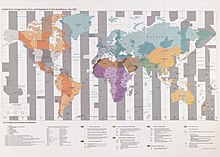
Back خدمة خارجية امريكا ARZ United States Foreign Service German Servicio Exterior de los Estados Unidos Spanish Service extérieur des États-Unis French United States Foreign Service Portuguese
 The flag of a U.S. Foreign Service officer | |
| Agency overview | |
|---|---|
| Formed | July 1, 1924[1] |
| Employees | 13,747[2] |
| Agency executive | |
| Parent department | Department of State |
| Map | |
 Map of U.S. Foreign Service posts (2003) | |
The United States Foreign Service is the primary personnel system used by the diplomatic service of the United States federal government, under the aegis of the United States Department of State. It consists of over 13,000 professionals[3] carrying out the foreign policy of the United States and aiding U.S. citizens abroad.[4][5] Its current director general is Marcia Bernicat.[6]
Created in 1924 by the Rogers Act, the Foreign Service combined all consular and diplomatic services of the U.S. government into one administrative unit. In addition to the unit's function, the Rogers Act defined a personnel system under which the United States secretary of state is authorized to assign diplomats abroad.
Members of the Foreign Service are selected through a series of written and oral examinations. They serve at any of the United States diplomatic missions around the world, including embassies, consulates, and other facilities. Members of the Foreign Service also staff the headquarters of the four foreign affairs agencies: the Department of State, headquartered at the Harry S Truman Building in the Foggy Bottom neighborhood of Washington, D.C.; the Department of Agriculture; the Department of Commerce; and the United States Agency for International Development.
The Foreign Service is managed by a director general who is appointed by the president of the United States, with the advice and consent of the Senate. The director general is traditionally a current or former Foreign Service officer (FSO).[7] Congress created the position of director general through the Foreign Service Act of 1946.
Between 1946 and 1980, the director general was designated by the secretary of state. The first director general, Selden Chapin, held the position for less than six months before being replaced by Christian M. Ravndal, who held the position until June 1949.[6][8] Both men were career FSOs.
Beginning on November 23, 1975, under a departmental administrative action, the director general has concurrently held the title of director of the Bureau of Global Talent Management.[8] As the head of the bureau, the director general held a rank equivalent to an assistant secretary of state.[8][9][10] Three of the last four directors general have been women.[6]
- ^ "In the Beginning: The Rogers Act of 1924". American Foreign Service Association. Retrieved February 24, 2018.
- ^ "GTM Fact Sheet" (PDF). U.S. Department of State. September 30, 2020. Retrieved August 8, 2022.
- ^ "What We Do: Mission". US State Department. Archived from the original on September 22, 2014. Retrieved October 10, 2017.
- ^ Kopp and Gillespie, Career Diplomacy, pp. 3-4
- ^ "What is the American Foreign Service Association?". Retrieved February 6, 2010.
- ^ a b c "Directors General of the Foreign Service - Principal Officers - People - Department History - Office of the Historian". history.state.gov. Retrieved December 21, 2019.
- ^ "22 U.S. Code § 3928 - Director General of Foreign Service". Cornell Law School. Retrieved December 9, 2015.
- ^ a b c "Directors General of the Foreign Service". U.S. Department of State, Office of the Historian. December 22, 2014. Retrieved December 9, 2015.
- ^ "Assistant Secretaries and Equivalent Rank". U.S. Department of State. January 20, 2009. Retrieved November 15, 2015.
- ^ "Department Organization Chart". U.S. Department of State. March 2014. Retrieved November 15, 2015.